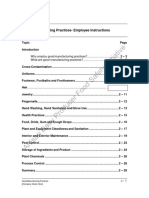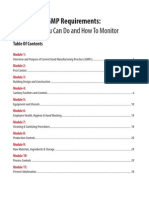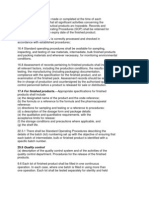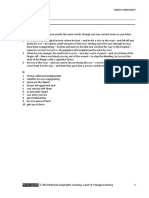GMP Policy Manual
GMP Policy Manual
Uploaded by
Gilbert PacariemCopyright:
Available Formats
GMP Policy Manual
GMP Policy Manual
Uploaded by
Gilbert PacariemCopyright
Available Formats
Share this document
Did you find this document useful?
Is this content inappropriate?
Copyright:
Available Formats
GMP Policy Manual
GMP Policy Manual
Uploaded by
Gilbert PacariemCopyright:
Available Formats
South Coast Business Solutions Evaluation Only
Demonstration Purposes Only
Good Manufacturing Practices (GMP) Policy Manual
In order to ensure that products are handled safely and effectively at all times whilst within the company premises a Good Manufacturing Practices (GMP) Policy Manual has been developed and implemented. All employees are responsible to ensure that Company Procedures are followed correctly and that Good Manufacturing Practices (GMP) Policy Manualis being complied with. Compliance is verified and recorded in accordance with Proc No 115.
Allergen Management
Cross Contamination Management of Cross Contamination is carried out in accordance with Proc No 140 Allergen Management.
Amenities
Hand Washing Detergent, sanitiser and hand drying facilities are available in employee amenities room and must be used in accordance with Procedure No 105. Toilets Toilets are to be well maintained and cleaned adequately, positioned within walking distance of all food related activities and not open directly to production facilities.
Equipment
Clothing Policy Rules for wearing, cleaning and changing clothing and PPE are contained in Procedure No's 105 and XXX. Food Contact Equipment Equipment in contact with food is to be stored, cleaned and maintained in such a manner as to prevent food contamination. Food Contact Surfaces Food contact surfaces are to be in good condition, well maintained and cleaned in such a manner as to prevent food contamination. Pallets Pallets are to be kept in good condition so as to prevent either damage to product or foreign object contamination. Preventive Maintenance Equipment is maintained in accordance with Proc No 135 Maintenance - Premises and Equipment Steel Wool Steel wool is expressly forbidden for use in cleaning of utensils
Prepared By A Quality Manager Approved By A Managing Director Approval Date 1/9/10
Page 1 of 4
Document No QA011.1 Issue No 1 Revision No 0
Document produced by HACCP Manager Software -www.scbs.net.au
Controlled Copy No 1
Good Manufacturing Practices (GMP) Policy Manual
Equipment
Wood The use of wood in all handling and processing areas is expressly forbidden for all food contact surfaces.
Glass Policy
Glass No glass equipment, utensils, containers or test tubes are permitted in Coolrooms, handling areas or processing areas. Glass thermometers, containers or jars are not to be used in these areas.
Manufacturing
Metal Detection Metal Detection is carried out in accordance with Proc No XXX Metal Detection Rework Rework is not undertaken by this company Waste Management Industrial Waste is managed in accordance with Proc No XXX Waste Management
Personnel
Dropped Product Dropped product or any product that has come into contact with any unsanitised or contaminated surface shall be immediately consigned to waste and is to be handled only by designated personnel. Dropped Tools & Utensils No processing aids that have come into contact with the floor or any other potentially contaminated surface shall be re used until they have been re cleaned in accordance with company cleaning procedures. Food Handlers - Illness & Injuries No staff member suffering from any illness, cut, abrasion or wound is to commence work without clearance from management. Hygiene And Sanitisation All staff members must be well presented and in clean clothing. No Jewelery is to be worn in processing areas. All staff must wash hands in accordance with Procedure No 105 prior to handling product. Smoking, Eating Drinking & Cosmetics Smoking is not permitted in coolrooms, handling areas, processing areas or dry goods and chemical storage areas. Eating and drinking is not permitted when handling product. Cosmetics that could potentially compromise food safety are not permitted. Staff Movement Care is to be taken by all staff and contractors when moving throughout the premises that cleaning and personal hygiene procedures appropriate to the areas being left and entered are complied with at all times.
Prepared By A Quality Manager Approved By A Managing Director Approval Date 1/9/10
Page 2 of 4
Document No QA011.1 Issue No 1 Revision No 0
Document produced by HACCP Manager Software -www.scbs.net.au
Controlled Copy No 1
Good Manufacturing Practices (GMP) Policy Manual
Personnel
Visitors & Contractors All visitors and contractors must report to the office and must comply with company Health and Hygiene procedure and Induction Procedure.
Premises
Construction and Layout Air is filtered where necessary and pressure differentials are in place between high and low risk production areas for potentially hazardous foods All areas for storage of ingredients, packaging; and cleaning, manufacturing and agricultural chemicals; and any flammable materials are secured, properly enclosed and adequately ventilated All incoming service lines such as gas, electricity, hot and cold water are adequately protected and clearly marked into processing areas. Covered drainage in wet areas (including footbaths) is in place, providing adequate outflow High & low risk areas of production are clearly segregated including coolrooms & other storage areas Lights are covered wherever they could shatter and impact on food safety. Adequate lighting is provided for clear working visibility On site laboratories are segregated from production areas , good laboratory practices are implemented in all on site laboratories; One way flow for manufacture of potentially hazardous foods has been considered and adopted where possible Premises are designed and constructed to minimise accumulation of dirt, debris and pests The quality of water, steam, ice, air, compressed air or gas that comes into contact with food or packaging, that in itself does not constitute an ingredient , is regularly monitored and presents no risk to product safety or quality . Walls, floors and ceilings are impervious and easily cleaned Windows and doors linked to storage and production areas are fitting and in good condition to control dust, vermin, and airborne organisms Environment Site boundaries to be clearly defined, fenced and secured if considered appropriate, free of potential harbourage for pests and adequately drained. Use Of Signs Appropriate signs will be placed throughout the premises wherever it is considered to be advantageous to Food Safety or Staff Safety. These signs should not be displayed in a manner that creates a risk of product contamination.
Prepared By A Quality Manager Approved By A Managing Director Approval Date 1/9/10
Page 3 of 4
Document No QA011.1 Issue No 1 Revision No 0
Document produced by HACCP Manager Software -www.scbs.net.au
Controlled Copy No 1
Good Manufacturing Practices (GMP) Policy Manual
Storage
Chemicals All hazardous, cleaning, pest control and testing chemicals are to be stored away from product in designated areas. Equipment All product handling equipment and tools to be stored off floors when not in use. Packaging All packaging materials to be stored in a clean, dry area on pallets or appropriate shelving. Open packages to be kept covered wherever possible. Product All product to be stored in coolrooms, off the floor in appropriate containers and at appropriate temperatures. Stock Rotation Stock rotation is managed in accordance with Proc No 215 Storage of Raw Materials Packaging and Chemicals and Proc No XXX Storage of Finished Product. Waste All waste to be stored in designated waste storage areas.
Transport
Vehicles Transport hazards are managed in accordance with Proc No 210 Receipt of Goods and Proc No XXX Loading and Delivery of Finished Products.
Prepared By A Quality Manager Approved By A Managing Director Approval Date 1/9/10
Page 4 of 4
Document No QA011.1 Issue No 1 Revision No 0
Document produced by HACCP Manager Software -www.scbs.net.au
Controlled Copy No 1
You might also like
- Complete Template For GMP ManualDocument18 pagesComplete Template For GMP ManualDanielson Culaniban67% (9)
- How To Build Up A GMP Quality ManualDocument17 pagesHow To Build Up A GMP Quality Manualjessari7396586% (7)
- GMP Policy ManualDocument3 pagesGMP Policy ManualAgnes_Agnes_Agnes100% (1)
- Handbook of Microbiological Criteria for FoodsFrom EverandHandbook of Microbiological Criteria for FoodsNo ratings yet
- ASEAN TMHS GMP Training Chapter 4 Annex 1 SOP On Personal HygieneDocument5 pagesASEAN TMHS GMP Training Chapter 4 Annex 1 SOP On Personal Hygienesunny mgxNo ratings yet
- SOP E03 Pest ControlDocument5 pagesSOP E03 Pest ControlSamsu Cahyo Hidayat100% (4)
- Ehaccp - Allergen Control SOPDocument2 pagesEhaccp - Allergen Control SOPAlfred Rangel100% (2)
- SOP 3 Good Manufacturing Practices Sample of Employee Instructions - WMDocument31 pagesSOP 3 Good Manufacturing Practices Sample of Employee Instructions - WMGeoff Erickson100% (2)
- Rajkumar Honey HACCP PlanDocument26 pagesRajkumar Honey HACCP PlanMarlan Cole80% (5)
- GMP ChecklistDocument17 pagesGMP ChecklistJan Vanmiddelem100% (1)
- GMP RequirementsDocument38 pagesGMP RequirementslaurenjiaNo ratings yet
- HACCP Plan TemplateDocument9 pagesHACCP Plan TemplateLedo Houssien100% (1)
- FSMS ManualDocument14 pagesFSMS ManualSusheel Talreja100% (4)
- GMP and HACCP AssignmentDocument3 pagesGMP and HACCP AssignmentPRINCESS DIANNE DUG-ANo ratings yet
- Model Recall PlanDocument22 pagesModel Recall PlanLeslie Quintana HuamalíesNo ratings yet
- Purpose & Scope: Procedure For Product Withdrawal & RecallDocument3 pagesPurpose & Scope: Procedure For Product Withdrawal & Recallsajid waqas100% (1)
- Mutharamman GoddessDocument2 pagesMutharamman GoddessPremNo ratings yet
- Daftar Harga Prewedding Photo Package PDFDocument4 pagesDaftar Harga Prewedding Photo Package PDFIka MayasariNo ratings yet
- Radium Creation Limited: 1. Personal Hygiene RequirementsDocument6 pagesRadium Creation Limited: 1. Personal Hygiene RequirementsStanley RascalNo ratings yet
- HACCP and SSOP BasicsDocument35 pagesHACCP and SSOP Basicsfitria lindasariNo ratings yet
- GMP Food Manufacturing Audit Checklist - SafetyCultureDocument22 pagesGMP Food Manufacturing Audit Checklist - SafetyCultureNaeema100% (2)
- Consolidated Standards Inspection: The AIB InternationalDocument52 pagesConsolidated Standards Inspection: The AIB InternationalakNo ratings yet
- Finished ProductDocument4 pagesFinished ProductDilip Chaudhary100% (1)
- OPRP 2 Management of Pest ControlDocument2 pagesOPRP 2 Management of Pest ControlAnggerNo ratings yet
- Crisis Managemen & Food DefenceDocument3 pagesCrisis Managemen & Food DefenceAgus WaluyoNo ratings yet
- Sample GMP ChecklistDocument2 pagesSample GMP ChecklistBaskaran Gangadharan0% (1)
- FSEP HACCP Template ManualDocument58 pagesFSEP HACCP Template ManualFloreid50% (2)
- Procedure Manual: Function: Haccp Support Programs Title: Allergen ManagementDocument3 pagesProcedure Manual: Function: Haccp Support Programs Title: Allergen Managementajan76100% (1)
- FSSC 22000 Manual DocumentsDocument10 pagesFSSC 22000 Manual Documentsmohamed kassemNo ratings yet
- GMP TrainingDocument3 pagesGMP TrainingPrince Moni100% (2)
- The Food Safety Enhancement Program Approach To A Preventive Control Plan - Canadian Food Inspection AgencyDocument39 pagesThe Food Safety Enhancement Program Approach To A Preventive Control Plan - Canadian Food Inspection AgencyAndreiNo ratings yet
- SOP E03 Pest ControlDocument5 pagesSOP E03 Pest ControlLiana ChouwNo ratings yet
- sSOP Production - (Company Name) : ScopeDocument3 pagessSOP Production - (Company Name) : ScopeAlfred Rangel100% (1)
- 18.SOP For Prevention of Cross ContaminationDocument3 pages18.SOP For Prevention of Cross ContaminationarunNo ratings yet
- Haccp Manual DocumentsDocument8 pagesHaccp Manual DocumentsHarits As SiddiqNo ratings yet
- 2 Food Loss and WasteDocument61 pages2 Food Loss and Wastemarani.1952816No ratings yet
- Training On Good Manufacturing PracticesDocument26 pagesTraining On Good Manufacturing PracticesxxkooonxxNo ratings yet
- Allergen Policy ExampleDocument1 pageAllergen Policy ExampleJorge G. ManzaneroNo ratings yet
- Preventive Cross ContaminationDocument5 pagesPreventive Cross ContaminationYousifNo ratings yet
- PNS Food Defense GuidanceDocument34 pagesPNS Food Defense GuidanceChristian Joseph0% (1)
- Mock Product RecallDocument20 pagesMock Product Recallgreatatiq007100% (1)
- PRP's For Manual GMPDocument13 pagesPRP's For Manual GMPShiva KumarNo ratings yet
- Haccp Amp Ssop Manual PDFDocument41 pagesHaccp Amp Ssop Manual PDFTiara Shafa Ayu100% (1)
- Food Safety Food Fraud GMP/PRP TrainingDocument61 pagesFood Safety Food Fraud GMP/PRP TrainingPaul Agra100% (5)
- Toc GMP Manual Ud12Document34 pagesToc GMP Manual Ud12navas1972100% (2)
- Basics of HACCP and Prerequisite ProgramsDocument22 pagesBasics of HACCP and Prerequisite ProgramsAnonymous A1G77Sw59100% (1)
- Example HACCP StudyDocument9 pagesExample HACCP Studycassilda_carvalho@hotmail.comNo ratings yet
- Goodmanufacturing Practice: Guidelines F O RDocument272 pagesGoodmanufacturing Practice: Guidelines F O RKhaled Adel100% (1)
- Product RecallDocument18 pagesProduct Recallmarkandey guptaNo ratings yet
- Manufacturing Practice Audit: (GMP Audit - Check List)Document31 pagesManufacturing Practice Audit: (GMP Audit - Check List)Sandra100% (1)
- Food Safety - Quality Policy - Environment PolicyDocument2 pagesFood Safety - Quality Policy - Environment PolicychungNo ratings yet
- Recall ManualDocument51 pagesRecall ManualKuda_Mutamba_9778100% (1)
- Doh Revised Guidelines On Current Good ManufacturingDocument25 pagesDoh Revised Guidelines On Current Good Manufacturingcharlimagne100% (3)
- FAO Guide to Ranking Food Safety Risks at the National LevelFrom EverandFAO Guide to Ranking Food Safety Risks at the National LevelNo ratings yet
- Food Defense A Complete Guide - 2020 EditionFrom EverandFood Defense A Complete Guide - 2020 EditionRating: 1 out of 5 stars1/5 (1)
- Food Control System Assessment Tool: Dimension B – Control FunctionsFrom EverandFood Control System Assessment Tool: Dimension B – Control FunctionsNo ratings yet
- Karnataka Textile and Garment Policy 2019-24 (1) - 0Document77 pagesKarnataka Textile and Garment Policy 2019-24 (1) - 0Vishwanath PatilNo ratings yet
- Module 5Document78 pagesModule 5Soumya VijoyNo ratings yet
- TextDocument5 pagesTextrugare JabangweNo ratings yet
- Freightliner s2 Chassis Maintenance ManualDocument10 pagesFreightliner s2 Chassis Maintenance Manuallindsey100% (58)
- I Am Roberto Clemente By:Jim GigliottiDocument2 pagesI Am Roberto Clemente By:Jim GigliottiAddyNo ratings yet
- Answer Key: Outcomes AdvancedDocument2 pagesAnswer Key: Outcomes AdvancedSereg LeiteNo ratings yet
- Sample 3Document6 pagesSample 3Jhon Jhon OrtegaNo ratings yet
- Microsoft 365 Communityver1fromMSDocument741 pagesMicrosoft 365 Communityver1fromMSbachankNo ratings yet
- Đề Cương LS2Document11 pagesĐề Cương LS2Linh TrươngNo ratings yet
- Vacancies (Job Advert)Document7 pagesVacancies (Job Advert)tahiru jaraaNo ratings yet
- Project Proposal MathFinalDocument12 pagesProject Proposal MathFinalRazorNo ratings yet
- Key TEST 1Document7 pagesKey TEST 1Hải PhươngNo ratings yet
- Daftar Akun PT ManunggalDocument4 pagesDaftar Akun PT ManunggalPetty Silvi Nova MaharlikaNo ratings yet
- Statement of FactsDocument14 pagesStatement of FactsAmithab SankarNo ratings yet
- General Motors: Submitted To Submitted byDocument25 pagesGeneral Motors: Submitted To Submitted bycool_techNo ratings yet
- WEDE5020POEDocument14 pagesWEDE5020POETatendaNo ratings yet
- Listening Test 1 - 10º - v1 WDDocument2 pagesListening Test 1 - 10º - v1 WDHenrique AlvesNo ratings yet
- Syria Urgent Call To Protect Civilians Caught Between Fires in Besieged Yarmouk CampDocument3 pagesSyria Urgent Call To Protect Civilians Caught Between Fires in Besieged Yarmouk CampimpunitywatchNo ratings yet
- Painting and Literature V. Woolf's To The Lighthouse" & Tracy Chevalier's Girl With A Pearl Earring"Document6 pagesPainting and Literature V. Woolf's To The Lighthouse" & Tracy Chevalier's Girl With A Pearl Earring"GeorgiAna NarcisaNo ratings yet
- Ae Notes 2Document275 pagesAe Notes 2Knowledge Mist ChannelNo ratings yet
- Ijp 17 5 Albrektsson 7Document8 pagesIjp 17 5 Albrektsson 7Ziad RabieNo ratings yet
- BBS 1st Year Financial Accounting Question PaperDocument3 pagesBBS 1st Year Financial Accounting Question Paperhealthywork142No ratings yet
- Port Huron Moose Lodge #158Document3 pagesPort Huron Moose Lodge #158Bryce AirgoodNo ratings yet
- Introduction To Sociology and Anthropology - 1Document12 pagesIntroduction To Sociology and Anthropology - 1Nafis Hasan khanNo ratings yet
- DRN Gearmotors CatalogDocument812 pagesDRN Gearmotors Catalogandreiwl100% (1)
- Thesis Plan TimetableDocument5 pagesThesis Plan TimetableKarla Long100% (2)
- Emily LloydDocument2 pagesEmily Lloydapi-358221917No ratings yet
- Navatara Chakra: March 1, 2013Document1 pageNavatara Chakra: March 1, 2013indians jonesNo ratings yet

























































































